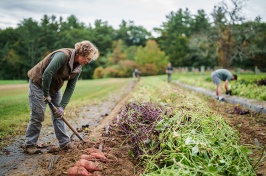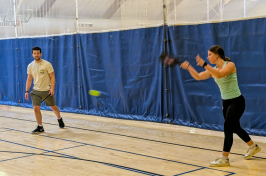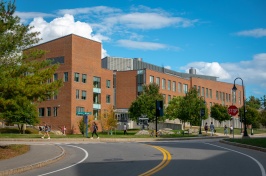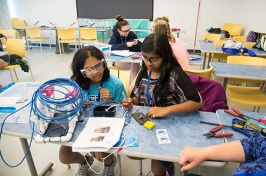Disease-Resistant Weed May Help Re-domesticate Quinoa in New England
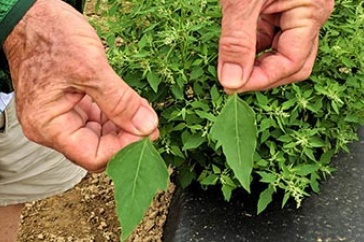
DURHAM, N.H.—Researchers with the New Hampshire Agricultural Experiment Station at the University of New Hampshire have discovered a native relative of quinoa with high disease resistance that may be an ideal breeding partner to re-domesticate the superfood in northern New England. A locally adapted source of quinoa would give the region’s farmers a new high-value grain crop that is in high demand across the nation.
“A key challenge when trying to farm quinoa is its susceptibility to disease, with downy mildew being the most destructive disease of quinoa worldwide,” said Haley Nolen, a graduate student in genetics who is working with university researchers Tom Davis and Anissa Poleatewich on the project. “We are trying to find native New England sources of disease resistance to breed with quinoa to produce a resistant variety of local quinoa. We hope that the protocol will be able to be applied to other quinoa growing regions.”
Davis, a geneticist, and his research team launched the quinoa breeding project in 2017 to develop a new high-value, local specialty crop for northern New England farmers.
“If we can successfully breed or re-domesticate a locally adapted quinoa variety that can be grown with commercial success, it would offer a new option to regional farmers interested in taking advantage of the current, very high price commanded by quinoa as a novel and highly nutritious grain crop,” Davis said.
According to the Food and Agricultural Organization of the United Nations, quinoa grain is a nutritional powerhouse that is high in protein, vitamins and fiber, and low in fat. Quinoa is almost exclusively grown in South America. However, its potential for cultivation elsewhere is being widely explored.
Global production of quinoa has been increasing significantly, surpassing 228 thousand metric tons in 2015, according to Statista. In 2014, the United States was the leading importer of quinoa in the world; U.S. quinoa imports totaled $159.12 million, or about 68.9 million pounds. The global price of quinoa has more than doubled from $2.96 per kilogram in 2010 to $6.74 per kilogram in 2014.
Researchers have been challenged by maintaining the pathogen downy mildew in the lab. Nolen explained that the pathogen needs a host to survive and cannot be cultured on artificial media like other fungi. As a result, she has been able to work with it only when it naturally occurs in the field during the summer.
Nolen also has discovered that the strain of downy mildew that infects quinoa here seems to be more closely related to South American populations of the pathogen than another North American population in Pennsylvania. She said this finding raises questions about the spread of the pathogen, which she is investigating.
“It is always a challenge to ‘get to know’ a new species chosen for study. We must learn how to grow the plants, how to perform genetic crosses, collect and germinate seed, differentiate among the wild species, and so on. It takes considerable time and effort to learn by doing,” Davis said.
This material is based upon work supported by the NH Agricultural Experiment Station, through joint funding of the National Institute of Food and Agriculture, U.S. Department of Agriculture, under award number 1006924, and the state of New Hampshire. This research also has been supported by the work of the Northern New England Collaborative Research Funding Program, a partnership of the Maine Agricultural and Forest Experiment Station, New Hampshire Agricultural Experiment Station, and Vermont Agricultural Experiment Station, NH Space Grant, and the UNH Graduate School.
Founded in 1887, the NH Agricultural Experiment Station at the UNH College of Life Sciences and Agriculture is UNH’s original research center and an elemental component of New Hampshire's land-grant university heritage and mission.
The University of New Hampshire inspires innovation and transforms lives in our state, nation and world. More than 16,000 students from all 50 states and 71 countries engage with an award-winning faculty in top-ranked programs in business, engineering, law, health and human services, liberal arts and the sciences across more than 200 programs of study. As one of the nation’s highest-performing research universities, UNH partners with NASA, NOAA, NSF and NIH, and receives more than $110 million in competitive external funding every year to further explore and define the frontiers of land, sea and space.
PHOTOS AVAILABLE FOR DOWNLOAD
https://colsa.unh.edu/nhaes/sites/default/files/media/images/pitseed_goosefoot.jpg
Researchers found a weedy species closely related to quinoa, Chenopodium berlandieri var. macrocalycium, or pitseed goosefoot, which is native to New England, has a high tolerance to downy mildew disease.
https://colsa.unh.edu/nhaes/sites/default/files/media/images/unhquinoaresearch.jpg
UNH launched the quinoa breeding project in 2017 to develop a new high-value, local specialty crop for Northern New England farmers.
-
Media Contact
Lori Tyler Gula, PhD | NH Agricultural Experiment Station | lori.gula@unh.edu | 603-862-1452
Latest News
-
August 21, 2025
-
August 12, 2025
-
August 5, 2025
-
June 25, 2025
-
June 16, 2025






















